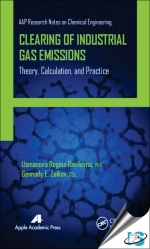Tab Article
Processes for clearing gases from dust in wet-type dust separators are widely applied in many industries for technological purposes and environmental control. Among goals of these processes is to ensure high efficiency of dust removal with minimum energy costs.
This book presents the newest scientific research data under the theory and practice of wet clearing of industrial gases from dispersion particles. The authors consider the modern aspects of the separation process and gas-dispersed impurities.
The book covers three main sections on working out and research of the following types of wet gas purifiers: dynamic scrubbers, wet gas clean apparatuses of shock-inertial act, and bubble dust traps. Each section considers the engineering and technological aspects of circuit design, including the theoretical fundamentals of process of gas cleaning, trial and error methods and calculation of apparatuses of wet gas cleaning, and construction of new gas clean apparatuses, their operational characteristics, and recommendations about application
In the literature there are no reliable methods of efficient clearing of gas emissions in scrubbers. This creates complexities at calculation and designing of these apparatuses and also complicates process intensification. The authors develop methods of calculation of process of gas cleaning on the basis of studying of hydrodynamic characteristics of apparatuses.


